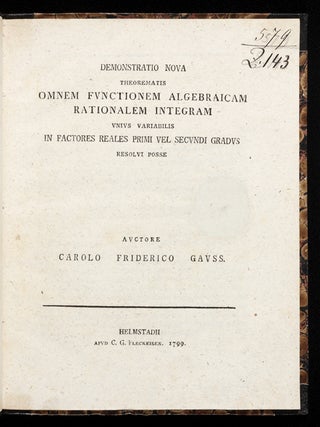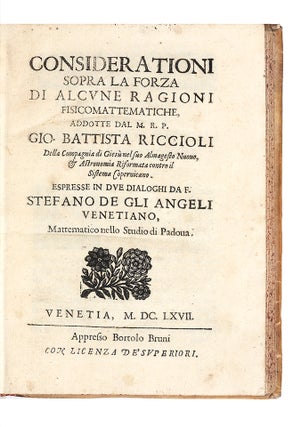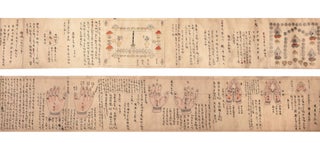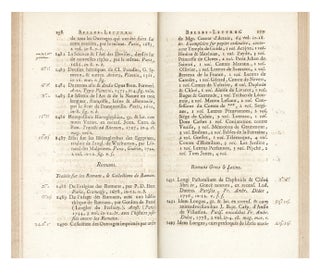Contains Texts That Would Have Been Lost Otherwise
Finely written manuscript on paper of Shuo fu lüe 說郛畧 [Outline of Shuo fu].
Brush & ink drawings in several vols. Ca. 1500 folding leaves. Ten vols. Thick 8vo (280 x 195 mm.), later wrappers, new stitching. [Japan]: from the final leaf of Vol. 10 (in approximate trans.): “The Buddhist practitioner Banjin copied this in Kinko [in today’s Kagoshima Prefecture] in 1721. I visited Banjin in 1737 and had conversations with him, [signed] Soko.”
Manuscript excerpts dating from after 1646, taken from Shuo fu 說郛, a collectanea (congshu 叢書) by Tao Zongyi 陶宗儀 (ca. 1316-ca. 1402), bibliophile and author; Shuo fu preserved a number of important documents and biographical data that would have been lost otherwise. Tao included a number of works — now unique — on Inner Asian dynasties and Southeast Asian kingdoms.
The title Shuo fu is rarely translated but comes from a phrase meaning “Heaven and earth form the castle walls of the myriad things; the Five Classics are the outer city walls (fu) of the numerous accounts (shuo).” Tao’s book collects excerpts from a very great number of Chinese literary works, so we can say that it functions to “wall in” these excerpts. Victor Mair and Christopher Atwood translate the title as Purlieus of Exposition.
Tao Zongyi was one of the most famous writers of the late Yuan (Mongol) and early Ming periods. He apparently had ambitions to serve in office under the Yuan, and might have done so briefly under the Ming (founded in 1368), but most of his career was spent as a teacher and writer. Shuo fu is a collectanea, a Chinese genre of books consisting of excerpts of other books. Never published in Tao’s lifetime, this collection of excerpts might have been intended for his own research purposes rather than for publication. Shuo fu is very important, as it contains excerpts from books that have since been lost. In total, over a thousand books are excerpted. Tao compiled a first version in 1361 but then continued revising it over the following decades.
The textual history of Shuo fu is very complicated. It apparently had 100 chapters (juan) when Tao was done with it. By the late 15th century, only 70 chapters survived. Around that time, one editor, Yu Wenbo 郁文博, added 30 chapters to reconstitute the original 100, but the additions had no connection to Tao Zongyi’s work. Our manuscript contains a preface by Yu Wenbo.
Between 1607 and 1620, a 120-chapter edition of Shuo fu was prepared, with a supplement of another 46 chapters. Other 120-chapter editions were then printed into the early Qing period (after 1644), with a varying number of books excerpted and with supplements of varying length. Zhang Zongxiang 張宗祥 (1882-1965) attempted to reconstruct a 100-chapter version based on different, incomplete manuscripts, and printed the resulting edition in 1927.
Our copy is in 10 volumes and contains neither 70 nor 100+ chapters. It is not a complete copy of any of these printed editions, but a selection, entitled Shuo fu lüe [Outline of Shuo fu]. We know of no printed edition of our manuscript nor any other manuscripts. Our copy has a preface by Yang Weizhen 楊維楨 that is found in several editions of Shuo fu. It also carries a preface on the “redone collation of Shuo fu,” written by Wang Yingchang 王應昌 in 1647 (Shunzhi 4). The copy also has a preface by Li Jiqi 李際期 (who passed the highest exams in 1640). Wang’s preface was initially written for Li’s 120-chapter 1646 edition, which Atwood calls a “mutilated edition” because it excluded selections from works dealing with Inner Asia, a politically sensitive subject in the early Qing period. Li’s edition was nevertheless the standard edition of Shuo fu until Zhang’s edition in 1927. From the presence of these two prefaces it appears that our Outline of Shuo fu was made on the basis of Li’s edition.
The fine brush & ink drawings depict actual elaborate seals and imprinted seals, with annotations, and coins (in the fifth volume) and ink stones (in Vol. 9).
We believe the “Banjin” who prepared this manuscript was Banjin Dotan (1698-1775), Buddhist monk, artist, and calligrapher.
A very fine set. Minor worming here and there. Preserved in a modern Japanese wooden box. The front panel contains a manuscript inscription (in trans.): “Hand-copied by Banjin. Setsuryaku seppu [the title in Japanese]. Ten volumes.”
❧ Atwood, Christopher P., “The Textual History of Tao Zongyi’s Shuofu: Preliminary Results of Stemmatic Research on the Shengwu Qinzheng Lu” in Sino-Platonic Papers 271 (2017), pp. 1-70–(a wonderful piece of bibliographical detective work).
Chang, Peter & Fang Chaoying, “T’ao Tsung-yi” in Dictionary of Ming Biography, Vol. 2, pp. 1268-72.
Endymion Wilkinson, Chinese History. A New Manual, 4th Edition, p. 783. Pelliot, Paul, “Quelques remarques sur le Chuou fou” in T’oung Pao 23.4 (1924), pp. 163-220.
Price: $15,000.00
Item ID: 8402

![Item ID: 8402 Finely written manuscript on paper of Shuo fu lüe 說郛畧 [Outline of Shuo fu]. Zongyi 陶宗儀 TAO.](https://jonathanahill.cdn.bibliopolis.com/pictures/8402.jpg?width=768&height=1000&fit=bounds&auto=webp&v=1662461416)
![Finely written manuscript on paper of Shuo fu lüe 說郛畧 [Outline of Shuo fu].](https://jonathanahill.cdn.bibliopolis.com/pictures/8402_2.jpg?width=320&height=427&fit=bounds&auto=webp&v=1662461416)
![Finely written manuscript on paper of Shuo fu lüe 說郛畧 [Outline of Shuo fu].](https://jonathanahill.cdn.bibliopolis.com/pictures/8402_3.jpg?width=320&height=427&fit=bounds&auto=webp&v=1662461416)
![Finely written manuscript on paper of Shuo fu lüe 說郛畧 [Outline of Shuo fu].](https://jonathanahill.cdn.bibliopolis.com/pictures/8402_4.jpg?width=320&height=427&fit=bounds&auto=webp&v=1662461416)
![Finely written manuscript on paper of Shuo fu lüe 說郛畧 [Outline of Shuo fu].](https://jonathanahill.cdn.bibliopolis.com/pictures/8402_5.jpg?width=320&height=427&fit=bounds&auto=webp&v=1662461416)
![Finely written manuscript on paper of Shuo fu lüe 說郛畧 [Outline of Shuo fu].](https://jonathanahill.cdn.bibliopolis.com/pictures/8402_6.jpg?width=320&height=427&fit=bounds&auto=webp&v=1662461416)
![Finely written manuscript on paper of Shuo fu lüe 說郛畧 [Outline of Shuo fu].](https://jonathanahill.cdn.bibliopolis.com/pictures/8402_7.jpg?width=320&height=427&fit=bounds&auto=webp&v=1662461416)
![Finely written manuscript on paper of Shuo fu lüe 說郛畧 [Outline of Shuo fu].](https://jonathanahill.cdn.bibliopolis.com/pictures/8402_8.jpg?width=320&height=427&fit=bounds&auto=webp&v=1662461416)
![Finely written manuscript on paper of Shuo fu lüe 說郛畧 [Outline of Shuo fu].](https://jonathanahill.cdn.bibliopolis.com/pictures/8402_9.jpg?width=320&height=427&fit=bounds&auto=webp&v=1662461416)
![Finely written manuscript on paper of Shuo fu lüe 說郛畧 [Outline of Shuo fu].](https://jonathanahill.cdn.bibliopolis.com/pictures/8402_10.jpg?width=320&height=427&fit=bounds&auto=webp&v=1662461416)
![Finely written manuscript on paper of Shuo fu lüe 說郛畧 [Outline of Shuo fu].](https://jonathanahill.cdn.bibliopolis.com/pictures/8402_11.jpg?width=320&height=427&fit=bounds&auto=webp&v=1662461417)
![Finely written manuscript on paper of Shuo fu lüe 說郛畧 [Outline of Shuo fu].](https://jonathanahill.cdn.bibliopolis.com/pictures/8402_12.jpg?width=320&height=427&fit=bounds&auto=webp&v=1662461417)
![Finely written manuscript on paper of Shuo fu lüe 說郛畧 [Outline of Shuo fu].](https://jonathanahill.cdn.bibliopolis.com/pictures/8402_13.jpg?width=320&height=427&fit=bounds&auto=webp&v=1662461417)



